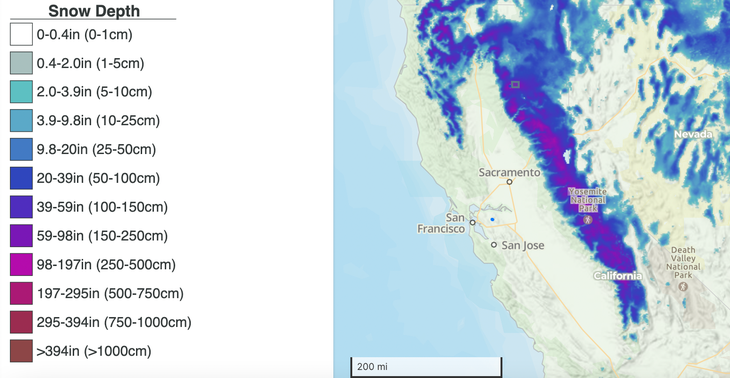Products You May Like
Get access to everything we publish when you
sign up for Outside+.
It’s been a great year for snow in California’s Sierra. Statewide, snowpack levels are 141% higher than usual. Some areas have been hit even harder: The Phillips Station near South Lake Tahoe, recently reported snow levels of 202% for that time of the year, while Lake Tahoe broke a 50-year record with 193.7 inches of snow by the end of December, according to University of California Berkeley’s Central Sierra Snow Lab.
But while the generous snowpack is good news for drought-starved reservoirs and the communities that depend on them, for aspiring Pacific Crest Trail hikers, they could be a real problem.
In a standard year, Sierra snowpack peaks in April. But it isn’t uncommon for the region to see snow storms into the month of May, meaning that the snowpack could still grow significantly. Arriving in the Sierras in June is considered early, and doing so could result in trekking through heavy snow and alpine conditions. A mid-season hike usually puts northbound hikers in the Sierras in early July, when high water levels from melting snow may make crossings swift and hazardous.

Over the past decade, the Tahoe area has seen an average of 272 inches of snow per season. By comparison, in December 2021 alone, the same region saw 212 inches of snow, making it one of the snowiest months on record. The Sierras haven’t seen such a dramatic display since 2019, when Lake Tahoe received 221 inches of snow in the month of February. The same year, this region saw about 580 inches of snowfall over the course of the season.
The consequences for hikers aren’t trivial. In 2019, many thru-hikers got off the trail to bypass the snow, and some of those who pushed through ended up so far behind schedule that they later threw in the towel. In 2017, another heavy snow year, the PCT saw several thru-hiker fatalities including two drownings in swollen rivers, one in the south fork of the Kings River and one in Yosemite’s Kerrick Canyon.
While deaths are extremely rare on the PCT, extenuating circumstances like high snow levels, and slick trails may make them more likely. Lesser injuries are more likely to occur too, as well as a higher incidence of search and rescue operations as hikers suffer falls on slick trails or end up with hypothermia. (The flip side: More snow could lead to a less-severe fire season, meaning fewer detours as hikers try to find their way around blazes.)
And after all that, these record-setting snows may not be enough to pull the state out of its longstanding dry spell. Sean de Guzman, the manager of California’s snow surveys, says he’s optimistic about the early season snowfall, which he hopes will boost the state’s water reservoirs. But he also noted that California is still in the grip of a drought, as 90% of the western US is.
With months still to go in the season, it’s too early to say with certainty what kind of snow thru-hikers should expect to see this season. But considering that some of California’s biggest snowfalls have historically occurred between January and March, they might want to start sharpening their ice axes.
